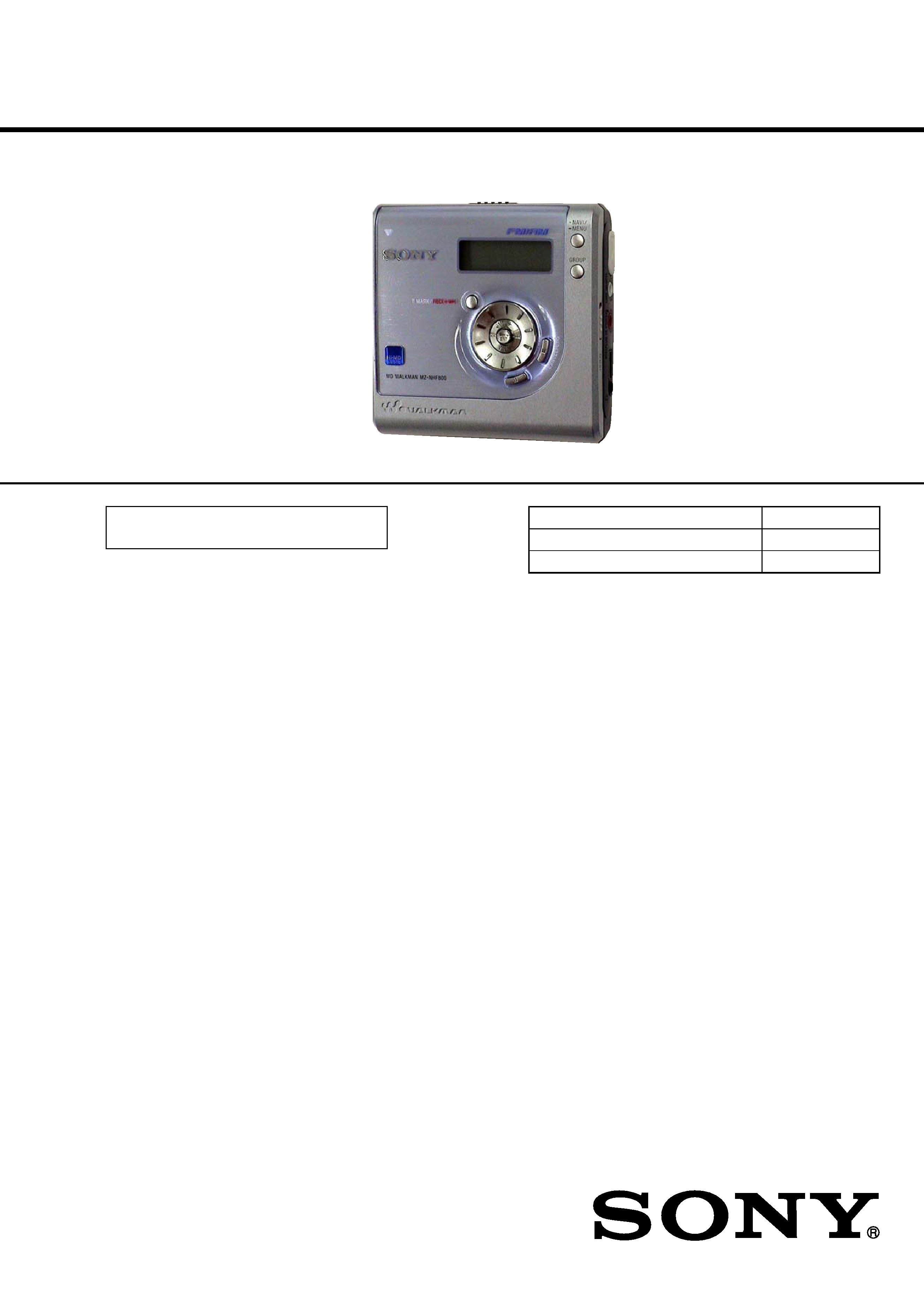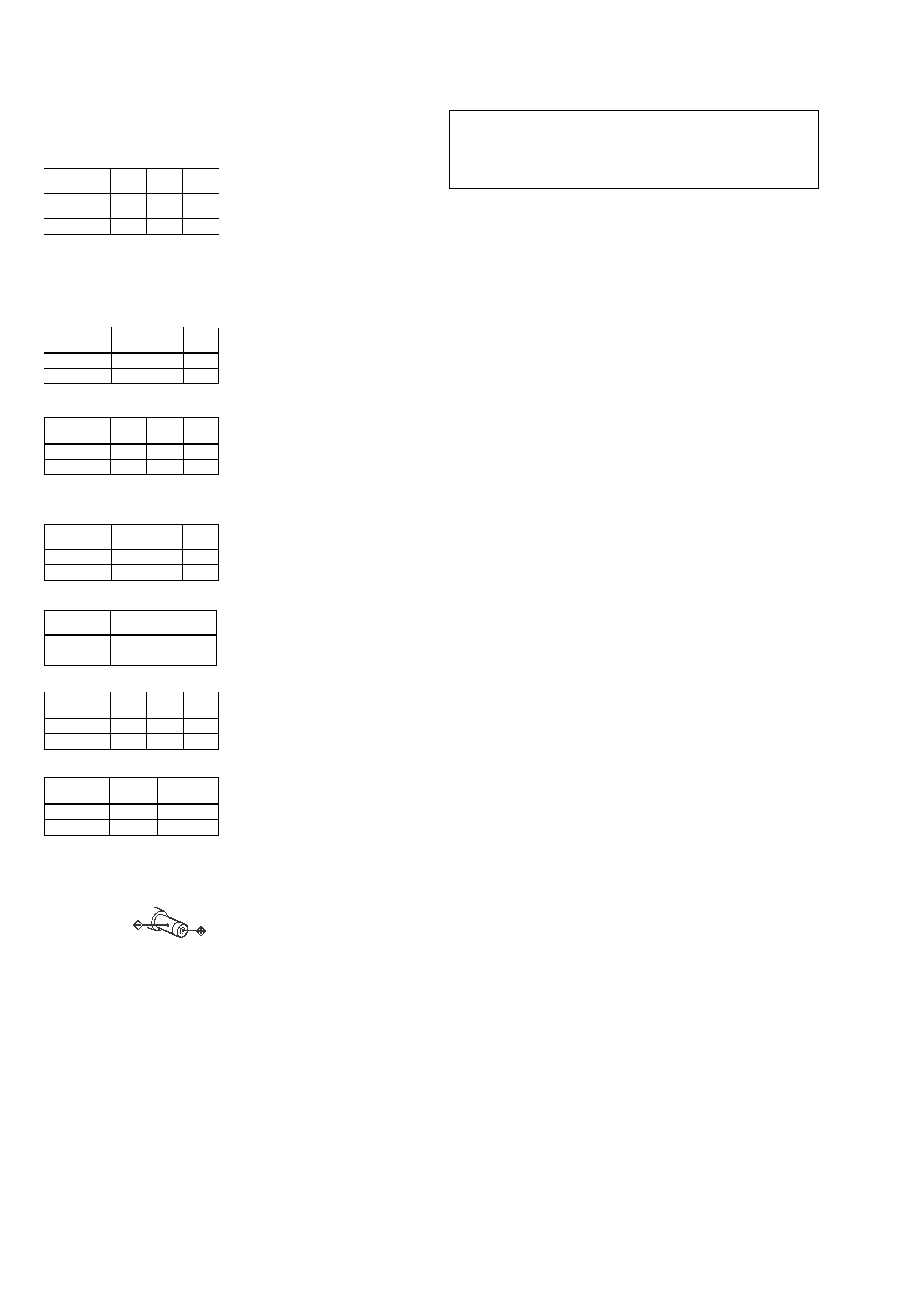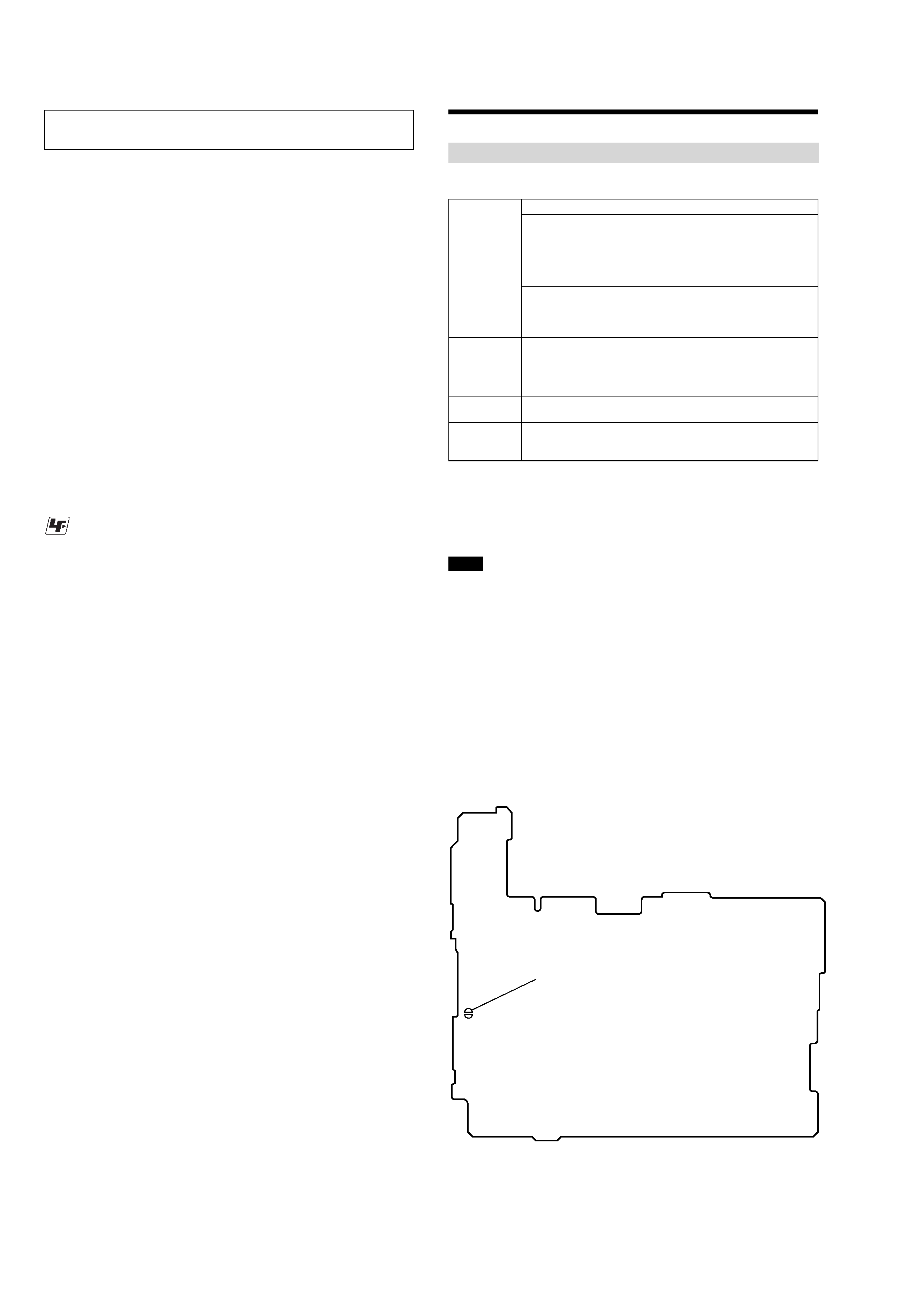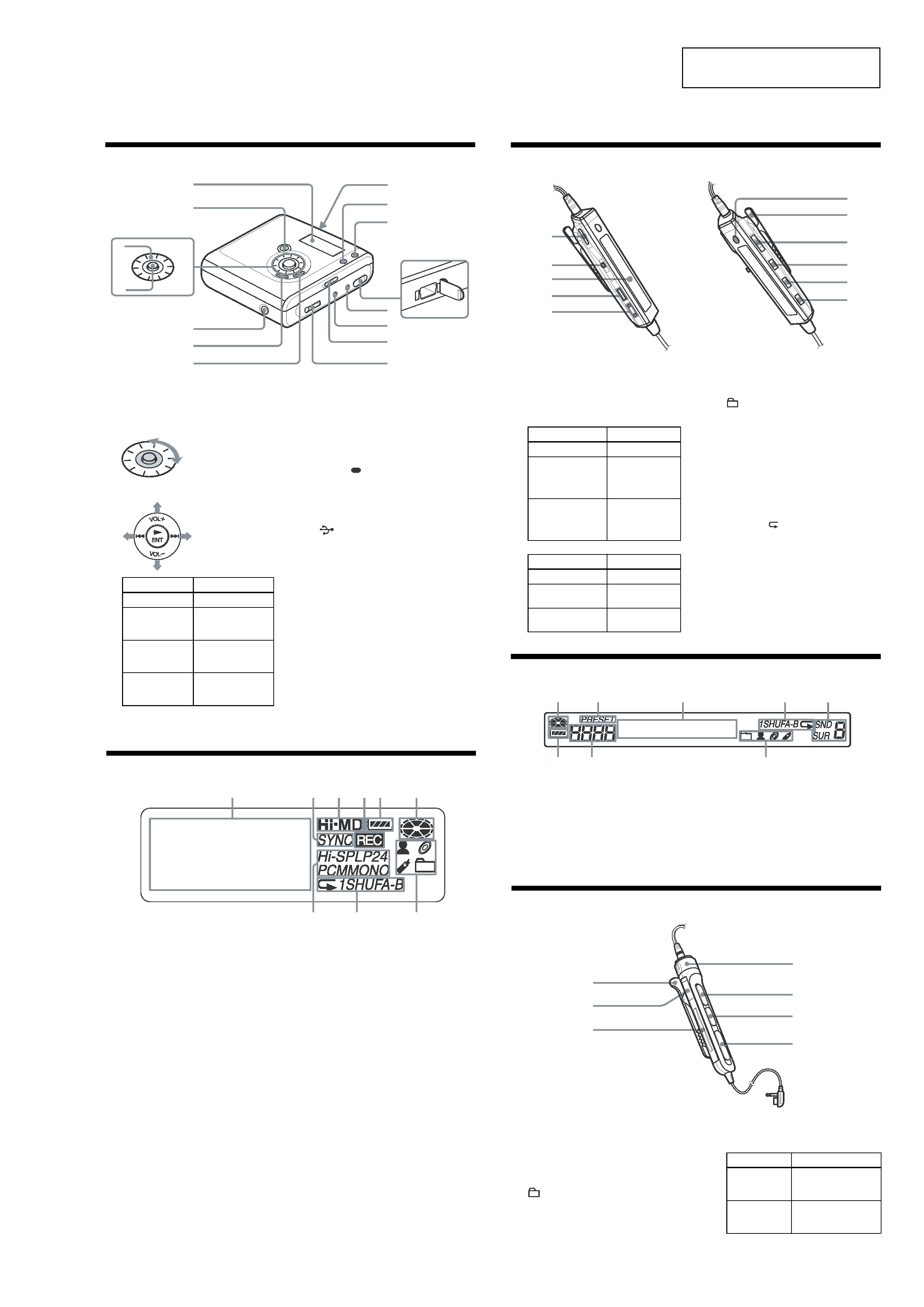
SERVICE MANUAL
MD recorder
Audio playing system
MiniDisc digital audio system
Laser diode properties
Material: GaAlAs
Wavelength:
= 790 nm
Emission duration: continuous
Laser output: less than 44.6
µW
(This output is the value measured at a distance of 200 mm from the
lens surface on the optical pick-up block with 7 mm aperture.)
Recording and playback time
When using HMD1G (1GB disc):
Maximum 34 hours in Hi-LP stereo
When using MDW-80 in Hi-MD mode:
Maximum 10 hours and 10 min. in Hi-LP stereo
When using MDW-80 in MD mode:
Maximum 160 min. in monaural
Maximum 320 min. in LP4 stereo
Revolutions
350 rpm to 3,000 rpm (CLV)
Error correction
Hi-MD:
LDC (Long Distance Code)/BIS (Burst Indicator Subcode)
MD:
ACIRC (Advanced Cross Interleave Reed Solomon Code)
Sampling frequency
44.1 kHz
Sampling rate converter
Input: 32 kHz/44.1 kHz/48 kHz
Coding
Hi-MD:
ATRAC3plus (Adaptive TRansform Acoustic Coding 3 plus)
MD:
ATRAC
ATRAC3
-- LP2/LP4
Modulation system
Hi-MD:
1-7RLL (Run Length Limited)/PRML
(Partial Response Maximum Likelihood)
MD:
EFM (Eight to Fourteen Modulation)
Frequency response
20 to 20,000 Hz
± 3 dB
Inputs
MIC: stereo mini-jack
(minimum input level 0.13 mV)
LINE IN (OPT)1):
stereo mini-jack for analog input (minimum input level 49 mV)
optical (digital) mini-jack for optical (digital) input
Outputs
i2): stereo mini-jack (dedicated remote control jack)
Maximum output (DC)
Headphones:
5 mW + 5 mW (24
) (USA model)
3 mW + 3 mW (16
) (European models)
5 mW + 5 mW (16
) (Other models)
Radio (MZ-NHF800)
Frequency range
USA model:
FM: 87.5 - 108.0 MHz
AM: 530 - 1,710 kHz (10 kHz step)
531 - 1,710 kHz (9 kHz step)
TV: 2 - 13 CH
WEATHER: 1 - 7 CH
Canadian model:
FM: 87.5 - 108.0 MHz
AM: 530 - 1,710 kHz (10 kHz step)
531 - 1,710 kHz (9 kHz step)
Models for Europe and China:
FM: 87.5 - 108.0 MHz
AM: 531 - 1,602 kHz
Other models:
FM: 87.5 - 108.0 MHz
AM: 530 - 1,710 kHz
Antenna
FM/TV/WEATHER:
Headphones/earphones cord antenna
AM:
Built-in ferrite bar antenna
General
Power requirements
Sony AC Power Adaptor connected at the DC
IN 3V jack:
120 V AC, 60 Hz (Models for USA, Canada, Mexico, and Taiwan)
230 V AC, 50/60 Hz (Models for continental Europe and Chile)
240 V AC, 50 Hz (Model for Australia)
230 V AC, 50 Hz (Models for U.K. and Hong Kong)
115 V/230 V AC, 50/60 Hz (Other models in MZ-NHF800)
100 - 240 V AC, 50/60 Hz (Other models in MZ-NH700)
The recorder:
Nickel metal hydride rechargeable battery
NH-7WMAA 1.2V 700 mAh (MIN) Ni-MH
LR6 (size AA) alkaline battery
AC power adaptor DC 3V
Operating temperature
+5
° C (+41° F) to +35° C (+95° F)
Dimensions
Approx. 81.0
× 29.2 × 78.9 mm (w/h/d)
(31/4
× 113/16 × 31/8 in.) (excluding projecting parts and controls)
Mass
Approx. 103 g (3.7 oz) (the recorder only)
Approx. 122 g (4.4 oz) (including the rechargeable battery)
1)The LINE
2)Measured in accordance with JEIAT.
IN (OPT) jack is used to connect either a digital
(optical) cable or a line (analog) cable.
PORTABLE MINIDISC RECEIVER
MZ-NH700/NHF800
Ver 1.1 2004.09
SPECIFICATIONS
Continued on next page
9-879-056-02
2004I05-1
© 2004.09
Sony Corporation
Personal Audio Company
Published by Sony Engineering Corporation
US and foreign patents licensed from Dolby
Laboratories Licensing Corporation.
Model Name Using Similar Mechanism
NEW
MD Mechanism Type
MT-MZNH900-181
Optical Pick-up Name
ABX-U
US Model
MZ-NHF800
Canadian Model
AEP Model
UK Model
E Model
Australian Model
MZ-NH700/NHF800
Chinese Model
Tourist Model
MZ-NH700
· SonicStage and SonicStage logo are trademarks or registered trademarks of Sony Corporation.
· MD Simple Burner, OpenMG, "Magic Gate", "MagicGate Memory Stick", "Memory Stick",
Hi-MD, Net MD, ATRAC, ATRAC3, ATRAC3plus and their logos are trademarks of
Sony Corporation.
· Microsoft, Windows, Windows NT and Windows Media are trademarks or registered
trademarks of Microsoft Corporation in the United States and /or other countries.
· IBM and PC/AT are registered trademarks of International Business Machines Corporation.
· Macintosh is a trademark of Apple Computer, Inc. in the United States and/or other countries.
· MMX and Pentium are trademarks or registered trademarks of Intel Corporation.
· All other trademarks and registered trademarks are trademarks or registered trademarks of their
respective holders.
Photo: MZ-NHF800

MZ-NH700/NHF800
2
Design and specifications are subject to change without notice.
Supplied accessories
AC power adaptor (1)
Remote control (1)
Headphones (for USA model) (1)
Dedicated USB cable (1)
Earphones (except USA model) (1)
NH-7WMAA Nickel metal hydride rechargeable battery (1)
CD-ROM (SonicStage/MD Simple Burner (1)*
Battery carrying case (1)
Hi-MD mode (When using a 60/74/80-minute standard disc)
(Unit: approx.hours)(JEITA)
Battery life
When recording continuously
Hi-MD mode (When using a 1GB Hi-MD disc)
(Unit: approx.hours)(JEITA3))
3) Measured in accordance with the JEITA (Japan Electronics and
Information Technology Industries Association) standard.
Batteries
Linear
PCM
Hi-SP
Hi-LP
NH-7WMAA
4)
4) When using a 100% fully charged nickel metal hydride rechargeable
battery
34.5
5
LR65)
5) When using a Sony LR6 (size AA)
"STAMINA" alkaline dry battery (produced in Japan)
2.5
3.5
4.5
Batteries
Linear
PCM
Hi-SP
Hi-LP
NH-7WMAA
2.5
4.5
5.5
LR6
58
9.5
On power sources
·For use in your house: use the AC power adaptor supplied with this
recorder. Do not use any other AC power adaptor since it may cause the
recorder to malfunction.
Polarity of the plug
Clamp filter (2)
Carrying pouch (except USA model)
Optical cable (MZ-NH700) (except Canadian andMexican Models) (1)
*Do not play a CD-ROM on an audio CD player.
MD mode
(Unit: approx.hours)(JEITA)
When playing continuously
Hi-MD mode (When using a 1GB Hi-MD disc)
(Unit: approx.hours)(JEITA)
Hi-MD mode (When using a 60/74/80-minute standard disc)
(Unit: approx.hours)(JEITA)
MD mode
(Unit: approx.hours)(JEITA)
When using the radio (MZ-NHF800)
(Unit: approx.hours)(JEITA)
Batteries
SP
Stereo
LP2
Stereo
LP4
Stereo
NH-7WMAA 4.5
6
6.5
LR6
7.5
9.5
11
Batteries
Linear
PCM
Hi-SP
Hi-LP
NH-7WMAA
4.5
7.5
9
LR6
11
18.5
21.5
Batteries
Linear
PCM
Hi-SP
Hi-LP
NH-7WMAA 47.5
9
LR6
9.5
17
20
Batteries
SP
Stereo
LP2
Stereo
LP4
Stereo
NH-7WMAA 7.5
9
10
LR6
20.5
24
26
Batteries
FM/AM
TV/Wb
(weather)6)
6) USA model only.
NH-7WMAA 7.5
7
LR6
18.5
17
Notes on chip component replacement
· Never reuse a disconnected chip component.
· Notice that the minus side of a tantalum capacitor may be
damaged by heat.
Flexible Circuit Board Repairing
· Keep the temperature of the soldering iron around 270 °C
during repairing.
· Do not touch the soldering iron on the same conductor of the
circuit board (within 3 times).
· Be careful not to apply force on the conductor when soldering
or unsoldering.
CAUTION
Use of controls or adjustments or performance of procedures
other than those specified herein may result in hazardous radiation
exposure.
SAFETY-RELATED COMPONENT WARNING!!
COMPONENTS IDENTIFIED BY MARK 0 OR DOTTED LINE
WITH MARK 0 ON THE SCHEMATIC DIAGRAMS AND IN
THE PARTS LIST ARE CRITICAL TO SAFE OPERATION.
REPLACE THESE COMPONENTS WITH SONY PARTS WHOSE
PART NUMBERS APPEAR AS SHOWN IN THIS MANUAL OR
IN SUPPLEMENTS PUBLISHED BY SONY.
ATTENTION AU COMPOSANT AYANT RAPPORT
À LA SÉCURITÉ!
LES COMPOSANTS IDENTIFIÉS PAR UNE MARQUE 0 SUR
LES DIAGRAMMES SCHÉMATIQUES ET LA LISTE DES
PIÈCES
SONT
CRITIQUES
POUR
LA
SÉCURITÉ
DE
FONCTIONNEMENT. NE REMPLACER CES COM- POSANTS
QUE PAR DES PIÈCES SONY DONT LES NUMÉROS SONT
DONNÉS DANS CE MANUEL OU DANS LES SUPPLÉMENTS
PUBLIÉS PAR SONY.

MZ-NH700/NHF800
3
TABLE OF CONTENTS
1.
SERVICING NOTES ................................................ 4
2.
GENERAL
Location of Controls ........................................................
5
3.
DISASSEMBLY
3-1.
Disassembly Flow ...........................................................
6
3-2.
Case (Lower) Section ......................................................
7
3-3.
MAIN Board ....................................................................
7
3-4.
Case (Upper) Section .......................................................
8
3-5.
Mechanism Deck Section (MT-MZNH900-181),
MD Standard Pin .............................................................
8
3-6.
Set Chassis Assy ..............................................................
9
3-7.
Gear (BSA), Gear (SB) ...................................................
9
3-8.
Op Service Assy .............................................................. 10
3-9.
DC Motor SSM18D/C-NP (Spindle) (M701),
DC Motor (Sled) (M702), DC Motor Unit
(Over Write Head Up/Down) (M703) ............................. 10
3-10. Holder Assy ..................................................................... 11
3-11. Position of Ferrite Core ................................................... 11
4.
TEST MODE .............................................................. 12
5.
ELECTRICAL ADJUSTMENTS ......................... 16
6.
DIAGRAMS
6-1.
Block Diagram MD SERVO Section ......................... 21
6-2.
Block Diagram AUDIO Section ................................. 22
6-3.
Block Diagram POWER SUPPLY Section ................ 23
6-4.
Schematic Diagram MAIN Section (1/9) ................... 25
6-5.
Schematic Diagram MAIN Section (2/9) ................... 26
6-6.
Schematic Diagram MAIN Section (3/9) ................... 27
6-7.
Schematic Diagram MAIN Section (4/9) ................... 28
6-8.
Schematic Diagram MAIN Section (5/9) ................... 29
6-9.
Schematic Diagram MAIN Section (6/9) ................... 30
6-10. Schematic Diagram MAIN Section (7/9) ................... 31
6-11. Schematic Diagram MAIN Section (8/9) ................... 32
6-12. Schematic Diagram MAIN Section (9/9) ................... 33
6-13. Printed Wiring Board MAIN Section (1/2) ................ 34
6-14. Printed Wiring Board MAIN Section (2/2) ................ 35
7.
EXPLODED VIEWS
7-1.
Case (Lower) Section ...................................................... 47
7-2.
Case (Upper) Section ....................................................... 48
7-3.
Chassis Section ................................................................ 49
7-4.
Mechanism Deck Section (MT-MZNH900-181) ............ 50
6.
ELECTRICAL PARTS LIST ................................ 51
Ver 1.1

4
MZ-NH700/NHF800
SECTION 1
SERVICING NOTES
The laser diode in the optical pick-up block may suffer electrostatic
break-down because of the potential difference generated by the
charged electrostatic load, etc. on clothing and the human body.
During repair, pay attention to electrostatic break-down and also
use the procedure in the printed matter which is included in the
repair parts.
The flexible board is easily damaged and should be handled with
care.
NOTES ON LASER DIODE EMISSION CHECK
The laser beam on this model is concentrated so as to be focused on
the disc reflective surface by the objective lens in the optical pick-
up block. Therefore, when checking the laser diode emission,
observe from more than 30 cm away from the objective lens.
NOTES ON HANDLING THE OPTICAL PICK-UP
BLOCK OR BASE UNIT
SL894
(OPEN/CLOSE)
MAIN Board (Conductor Side)
UNLEADED SOLDER
Boards requiring use of unleaded solder are printed with the lead-
free mark (LF) indicating the solder contains no lead.
(Caution: Some printed circuit boards may not come printed with
the lead free mark due to their particular size)
: LEAD FREE MARK
Unleaded solder has the following characteristics.
· Unleaded solder melts at a temperature about 40 °C higher
than ordinary solder.
Ordinary soldering irons can be used but the iron tip has to be
applied to the solder joint for a slightly longer time.
Soldering irons using a temperature regulator should be set to
about 350
°C.
Caution: The printed pattern (copper foil) may peel away if
the heated tip is applied for too long, so be careful!
· Strong viscosity
Unleaded solder is more viscou-s (sticky, less prone to flow)
than ordinary solder so use caution not to let solder bridges
occur such as on IC pins, etc.
· Usable with ordinary solder
It is best to use only unleaded solder but unleaded solder may
also be added to ordinary solder.
Providing the required system environment
The following system environment is required in order to use the SonicStage/MD Simple
Burner software for the MD Walkman.
This software is not supported by the following environments:
·OSs other than the indicated above
·Personally constructed PCs or operating systems
·An environment that is an upgrade of the original manufacturer-installed operating system
·Multi-boot environment
·Multi-monitor environment
·Macintosh
·We do not ensure trouble-free operation on all computers that satisfy the system requirements.
·The NTFS format of Windows XP/Windows 2000 Professional can be used only with the standard
(factory) settings.
·We do not ensure trouble-free operation of the system suspend, sleep, or hibernation function on all
computers.
·For Windows 2000 Professional users, install Service Pack 3 or later version before using the
software.
System requirements
Computer
IBM PC/AT or Compatible
· CPU: Pentium II 400 MHz or higher (Pentium III 450 MHz or higher
is recommended.)
· Hard disk drive space: 200 MB or more (1.5 GB or more is
recommended) (The amount space will vary according to Windows
version and the number of music files stored on the hard disk.)
· RAM: 64 MB or more (128 MB or more is recommended)
Others
· CD drive (capable of digital playback by WDM)
· Sound Board
· USB port (supports USB (previously USB 1.1))
Operating
System
Factory installed:
Windows XP Media Center Edition 2004/Windows XP Media Center
Edition/Windows XP Professional/Windows XP Home Edition/
Windows 2000 Professional/Windows Millennium Edition/Windows
98 Second Edition
Display
High Color (16bit) or higher, 800
× 600 dots or better (1024 × 768 dots
or better is recommended)
Others
· Internet access: for Web registration, EMD services and CDDB
· Windows Media Player (version 7.0 or higher) installed for playing
WMA files
Notes
OPERATION CHECK WHEN THE LID IS OPEN
In making an operation check with the MAIN Board removed from
the set, short the SL894 (OPEN/CLOSE) of the MAIN Board with
the solder before starting the operation check.
Note: Be sure to remove the solder used for shortcircuit after the repaire
completed.

5
MZ-NH700/NHF800
SECTION 2
GENERAL
This section is extracted from
instruction manual.
Looking at controls
The recorder
A Display window
B T MARK/REC (+N) button
C Jog dial
D 5-way control key
E DC IN 3V jack
F X (pause) button
G x (stop)
· CANCEL/CHG button
H OPEN switch
I GROUP button
J
·NAVI/ MENU button
Press lightly to go to the NAVI
(navigation) setting mode.
Press for 2 seconds or more to go to
MENU setting mode.
K
USB cable connecting jack
1
4
3
qs
qd
qf
qg
2
5
6
7
qa
9
8
q;
Operation
Function
Press NENT 1) play, enter
Press towards
.
find the beginning
of the previous
track, rewind
Press towards
>
find the beginning
of the next track,
fast forward
Press towards
VOL +1) or
VOL
-.
volume
1) There are tactile dots beside the NENT
and
VOL + buttons.
L LINE IN (OPT) jack
M MIC (PLUG IN POWER) jack
There is a tactile dot beside the MIC
(PLUG IN POWER) jack.
N HOLD switch
Slide the switch in the direction of the
arrow to disable the buttons on the
recorder. To prevent the buttons from
being accidentally operated when you
carry the recorder, use this function.
O i (headphones/earphones) jack
The display window of the recorder
A Character information display
Displays the disc and track names,
date, error messages, track numbers,
etc.
B SYNC (synchro-recording) indication
C Hi-MD/MD indication
"Hi-MD" lights up when the
operation mode of the recorder is in
Hi-MD mode and "MD" lights up
when the operation mode is in MD
mode.
D REC indication
Lights up during recording or file
transfers from the computer. When
flashing, the recorder is in record
standby mode.
E Battery indication
Shows the approximate remaining
battery power. If the battery is weak,
the indication becomes empty and
starts flashing.
F Disc indication
Shows that the disc is rotating for
recording or playing.
G Track mode (PCM, Hi-SP, Hi-LP, SP,
LP2, LP4, MONO) indication
H Sub play mode/Repeat play
indications
Shows the selected Sub play mode
(single-track play, shuffle play, etc.) or
Repeat play.
I Main play mode indications
Shows the selected main play mode
(group play, bookmark play, etc.).
12
3
4 5
6
78
9
The headphones/earphones with a remote control
(MZ-NHF800)
A VOL +,
- buttons
Press to adjust the volume.
B Jog lever (NX/ENT, ., >
·
BAND, TUNE
-, TUNE +)
When using an MiniDisc
When using the radio
C Display window
D x (stop) button
E
(group) +,
-
F RADIO ON/OFF button
Press to turn on or off the radio.
G Clip
H HOLD switch
To prevent the buttons from being
accidentally operated when you carry
the recorder, use this function.
I DISPLAY button
J P-MODE/
button
K SOUND button
B
C
D
E
A
F
G
H
I
J
K
Operation
Function
Press NX/ENT
play, pause, enter
Slide towards
.
find the
beginning of the
previous track,
rewind
Slide towards
>
find the
beginning of the
next track, fast
forward
Operation
Function
Press BAND
select a band
Slide towards
TUNE
-
tune backwards
Press towards
TUNE +
tune forward
The display window of the remote control (MZ-NHF800)
A Disc indication
B PRESET indication
C Character information display
D Sub play mode/Repeat play
indications
E SND (sound) and SUR (surround)
indications
F Battery level indication
G Track number/Band/Preset number
display
H Main play mode indications
12
3
4
8
7
6
5
The headphones/earphones with a remote control
(MZ-NH700)
A Clip
B HOLD switch
To prevent the buttons from being
accidentally operated when you carry
the recorder, use this function.
C
(group) +,
- buttons
D Volume control (VOL +,
-)
Turn to adjust the volume.
E NX (play, pause) button
F x (stop) button
G ., > buttons
1
4
5
6
7
3
2
Operation
Function
Press .
find the beginning of
the previous track,
rewind
Press >
find the beginning of
the next track, fast
forward
